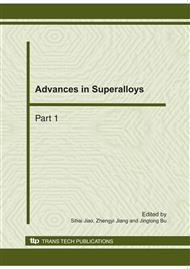p.926
p.937
p.941
p.948
p.953
p.962
p.966
p.972
p.976
Effects of Ge Doping on Electrochemical Migration, Corrosion Behavior and Oxidation Characteristics of Lead-Free Sn-3.0Ag-0.5Cu Solder for Electronic Packaging
Abstract:
Due to lead-free pressure, Sn-Ag-Cu solder is regarded as the potential candidate. However, higher melting point and faintish soldering restrict its wide application. Metal or rare earth metal doping can improve its soldering. In this thesis, Ge doping in Sn-3.0Ag-0.5Cu (SAC) solder were discussed. Effect of metal Ge doping on electrochemical corrosion behavior of lead-free SAC solder in 3wt.% NaCl solution were investigated by potentiodynamic polarization measurement. The electrochemical migration(ECM)attributed to dendrites growth were employed by the salt immersion experiment, and the oxidation characteristic was researched by thermo gravimetric analysis(TGA). The surface morphology and elemental composition of various elements in the doped solder were determined by analyzing the corrosion product or dendrites formed on the specimen by SEM, EDAX techniques. The results showed that the dendrite growth can be accelerated after Ge doping comparing to Sn-3.0Ag-0.5Cu solder. The shapes of dendrites were completely different before and after Ge doping, the fore looked like as tree leaves, the latter looked like little stem, all dendrites grown from different kind of material can be well differentiated by the help of their fractal dimension. EDAX result showed that the content on dendrites of Sn-3.0Ag-0.5Cu solder doping with Ge were mainly Sn, only little Cl- and Na+. Corrosive experiment showed that the corrosive current density (Icorr) increased with Ge content increasing when the percent content of Ge was less than or equal to 1%, the contrary effect suitable to that Ge doping larger than 1%. TGA result showed that Ge doping could improve the anti-oxidation capacity of SAC solder comparing to no doped solder. It provided a good technical support to develop a new lead-free solder substituting for Sn-37Pb.
Info:
Periodical:
Pages:
953-961
Citation:
Online since:
October 2010
Authors:
Price:
Сopyright:
© 2011 Trans Tech Publications Ltd. All Rights Reserved
Share:
Citation:


